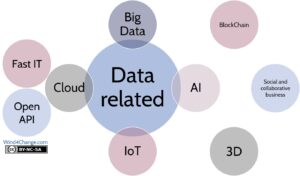Digital & Innovation

What are the main innovation frameworks?
First, we introduce the frameworks related to innovation to be combined to get an end-to-end process: Design Thinking, Lean Start-Up, Agile, Outcome Driven Innovation, Impact Mapping and Story Mapping. Combining several relevant frameworks is difficult as they have their own focused areas: they may have overlaps, be more or less relevant than the others for a given area or there may be gaps in the full scope to cover.
How to combine theses innovation frameworks in a single process?
Then, we review the result of the combination of these innovation frameworks in a single process. We look at each step with activities and deliverables.
What is digital?
Is Digital a bunch of new disruptive technologies? Is it a new way of doing business? How does agile fit in the picture?
What are the disruptive technologies?
Discover the disruptive technologies considered as part of the digital revolution. We will start with those that are Data Related: Big Data, Artificial Intelligence, Internet of Things and Cloud Computing. Then we will review Blockchain, Social & collaborative business and 3D. And at last, those directly connected to Continuous Delivery: Fast IT and Open API.
What is Customer Experience?
Learn about the paradigm shift from Product or Service to Customer Experience.
What are coopetion and platform business model?
Explore the second paradigm shift, coopetition also called platform business model: a new form of collaboration with competitors, partners and customers.
What is the Data Revolution?
Dig out the third paradigm shift: from planned measurements to a deluge of data coming from everywhere and used everywhere. This is the Data Revolution. “Data is the new oil“, as quoted the Mathematician Clive Humby in 2006.
What is Value Volatility?
Review the fourth paradigm shift: from stable to volatile value. This volatility involves the treat of disruption that can be related to Joseph Schumpeter’s creative creation. It explains the need to differentiate and innovate.
How does Agile fit in the Digital Revolution picture?
At last, get the picture on how agile fits in the picture. How agile supports the Digital Revolution and the limits where dedicated actions are required.

